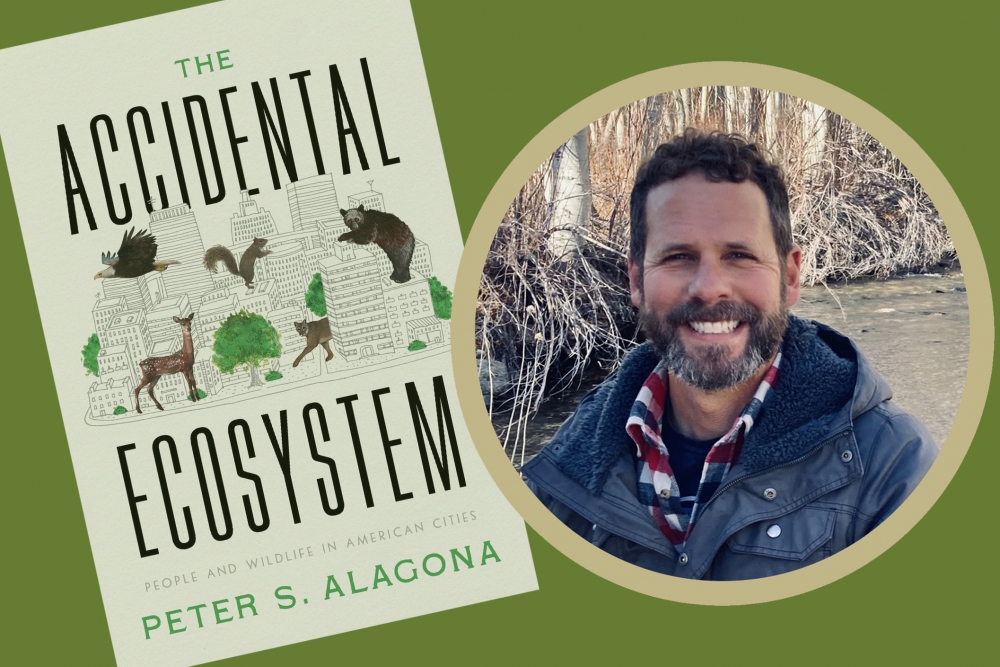
‘The Accidental Ecosystem’
Pigeons and squirrels, rabbits and crows: all familiar sights for the inhabitants of American cities. But a bobcat? And yet there one was, peering at Peter Alagona from the bushes just beside the suburban bike path he routinely took to work. “We locked eyes for several seconds,” he writes, “two mammals in the ancient act of sizing each other up.”
While perhaps his most startling encounter, the bobcat was far from Alagona’s first run-in with urban wildlife, and he knows he’s not alone. “So many people have all of these stories because they see these creatures; they live with them; they interact with them,” said the environmental historian, an associate professor at UC Santa Barbara. “But people don’t always know why they’re there; what they’re doing; or how they make a living.”
It was these questions that prompted his second book, “The Accidental Ecosystem,” which tells the story of how American cities filled with wildlife. Alagona hopes the book catalyzes a conversation about how to reimagine our cities as shared, multispecies habitats.
In many ways the story of urban wildlife is also the history of cities. Humans often establish settlements in locations rich in resources and biological productivity. They were frequently developed around strategic sites — like rivers, estuaries and bays — dictated by geography and transportation. These are all characteristics that favor a thriving ecosystem as well, meaning many contemporary urban areas were flush with wildlife before they were settled.
Cities have always had plenty of animals, as Alagona points out early on. Before refrigeration and automobiles, domesticated animals like chickens, cattle and horses were commonplace in urban environments. But the push for cleaner, healthier cities in the mid to late 1800s saw many of these animals moved out of urban centers. According to the author, it was only when domesticated animals left that wildlife could begin to return.
In fact, he argues that the efforts to clean up cities were so successful that many of us forgot animals were ever a part of the urban setting. “Americans in particular still mostly believe that wild creatures belong in wild places. And in particular, wilderness,” Alagona explained. “When they see these creatures in urban areas, people tend to think that they’re out of place.”
This is certainly not how wild animals view cities, though. Animals see a habitat with resources, opportunities and hazards. If a population endures, that suggests the city is providing a suitable habitat. And many animals have been able to make a living in the constructed environment, from downtown regulars, like rats and sparrows, to more noteworthy animals like the bobcat Alagona met along his commute.
In the book, he also discusses attributes that help animals adapt to urban settings, finding that many species that flourish in cities share certain characteristics. They’re often omnivores and generalists that can live in a wide variety of environments: think coyotes and rats. Many successful species also care for their young and share information with each other, for instance sea lions and crows. In short, they’re a lot like us.
With cities, humans have not only created a habitat for ourselves. We also have inadvertently created a habitat for animals that are similar to us. All we had to do was allow them to settle in. “That’s the ‘accidental’ part of ‘The Accidental Ecosystem,’ ” Alagona said.
The book includes 10 full-page illustrations of some of our cities’ wilder residents. Alagona included them to convey the idea that these animals are characters in an unfolding drama, one that we’re a part of as well. “They’re our neighbors,” he said. “They can sometimes be inconvenient, but they also provide us with a range of benefits.” They pollinate plants, scavenge waste and consume pests. Urban wildlife can also alert us to potential threats, such as emerging diseases, and provide us with moments of surprise and wonder as we go about our daily lives.
Alagona also contends that cities are a new kind of ecosystem that brings together creatures in novel arrangements and associations. “These spaces are so new that no species that lives in them is truly adapted to them in any deep, evolutionary sense,” he said. “Cities bring together diverse creatures in new ways.”
The novelty of urban ecosystems invites us to consider what kinds of spaces we want, what kinds of creatures we want to share them with, and what kinds of habitats can promote mutual thriving. At the individual level, this could involve planting native gardens, keeping cats indoors, or minimizing the harmful chemicals we put into our neighborhoods. At large scales, these efforts include maintaining urban forests, implementing measures to reduce bird strikes and roadkill, and designing parks and open spaces with wildlife in mind.
Toward the end of the book, Alagona makes the case that it’s time to transition cities from accidental to intentional ecosystems. “It’s not just doom and gloom,” he said. “There are so many opportunities in urban ecosystems. Sometimes opportunities even happen by accident.”



